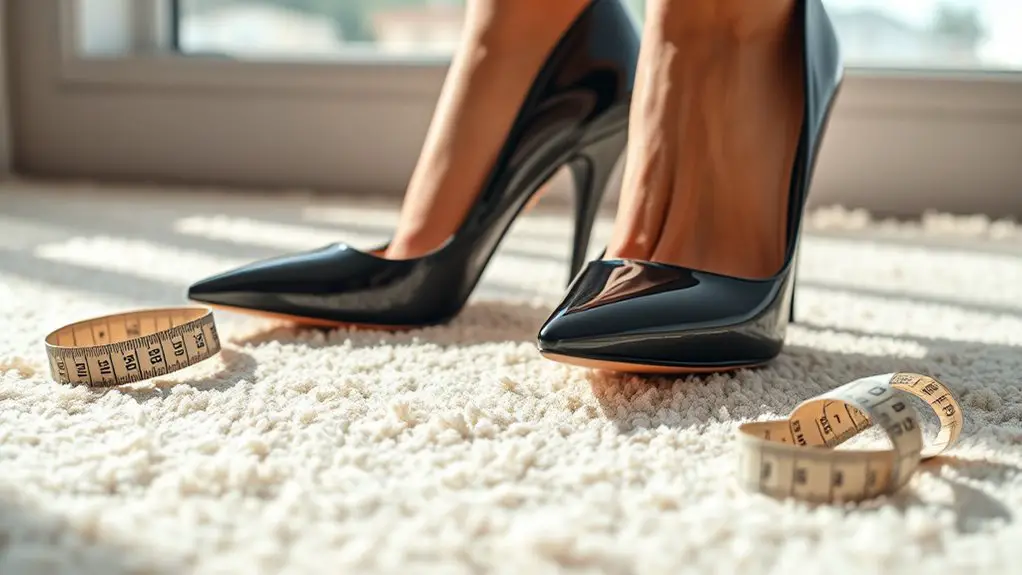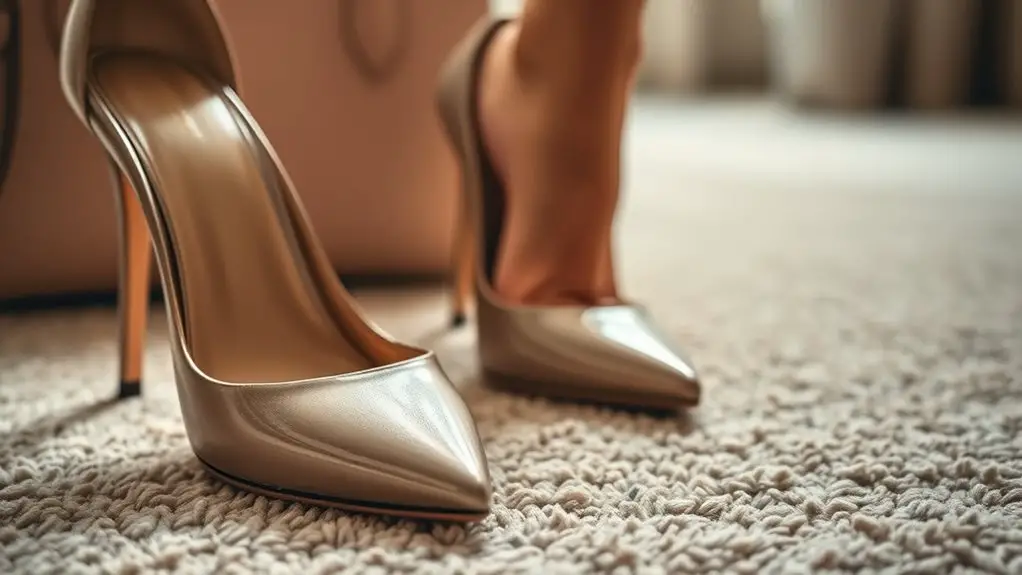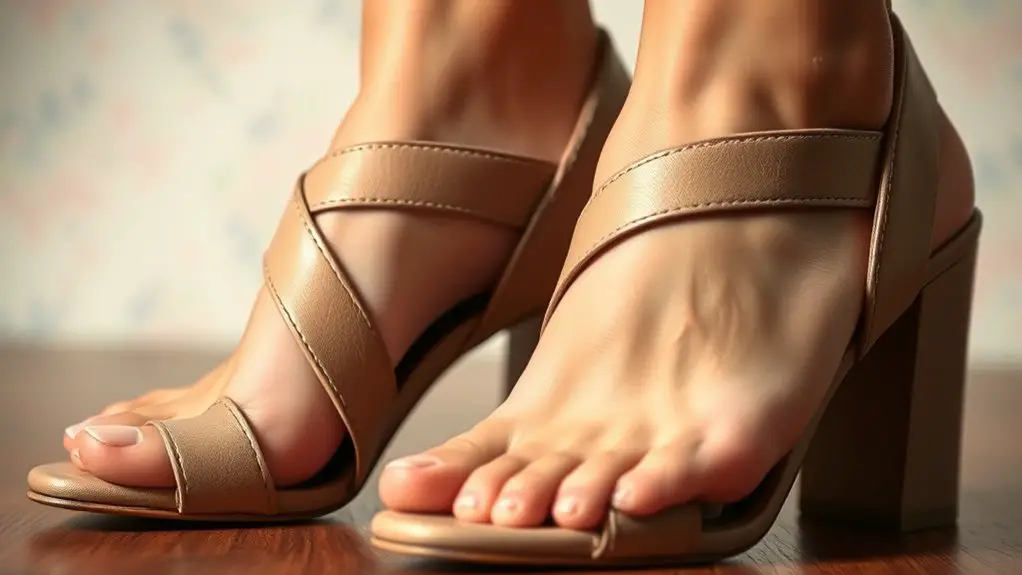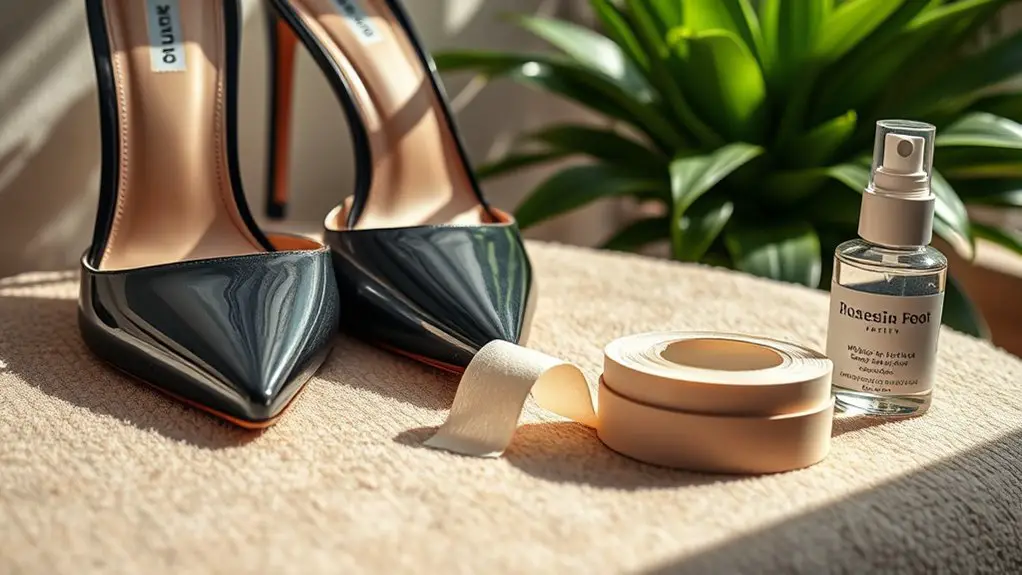To make your heels more comfortable, start by ensuring the right size and fit; measure your feet accurately and consider wider options. Invest in quality inserts with good arch support and cushioning. Moleskin or gel pads can reduce friction and pressure on specific areas. Gradually break in new shoes by wearing them in short increments. Choose styles with wider straps or block heels for added stability. Keep your feet moisturized too, and there are more tips to explore.
Choose the Right Size and Fit

When you’re shopping for heels, it’s important to prioritize size and fit, as even the most stylish pair can become unbearable if they don’t fit properly. Start by taking accurate heel measurements, ensuring you know your size in different brands, as sizing can vary. Don’t forget to measure foot width, as this can greatly affect comfort. Many brands offer narrow, regular, and wide options, so choose accordingly.
When trying on heels, pay attention to how they feel. Your toes shouldn’t feel cramped, and your heel should stay snug without slipping. Walk around to assess support and stability. If you’re between sizes, opt for the larger size, as you can always add insoles for a better fit. Remember, a well-fitting heel not only looks good but also helps prevent blisters and discomfort, making your experience much more enjoyable.
Invest in Quality Inserts
Investing in quality inserts can greatly enhance the comfort of your heels. Not all shoe materials provide adequate cushioning and support, which is where inserts come in. Look for ones that offer substantial arch support; this can help alleviate pressure on your feet, especially during long wear. High-density foam or gel inserts are often recommended, as they adapt to your foot’s shape while providing cushioning.
When selecting inserts, consider the specific type of heel you’re wearing. Thinner, more flexible materials might be suitable for dressy heels, while sturdier options may be better for block heels. Ascertain the inserts fit snugly within your shoe without causing overcrowding. By prioritizing quality, you’ll notice a significant reduction in discomfort and fatigue, allowing you to enjoy your heels for longer periods. Don’t underestimate the difference that well-chosen inserts can make in your overall wearing experience.
Use Moleskin or Gel Pads

Moleskin and gel pads are two effective solutions for enhancing comfort in heels, and they can make a noticeable difference in your wearing experience. Moleskin application involves cutting the fabric into appropriate shapes to cover areas where friction occurs, protecting your skin and alleviating pain. Gel pads, on the other hand, provide cushioning and support, reducing pressure on the balls of your feet.
Here’s a quick comparison of these options:
| Feature | Moleskin |
|---|---|
| Application | Adhesive backing, easy to cut |
| Comfort Level | Reduces friction |
| Durability | Short-term use |
| Feature | Gel Pads |
| Application | Stick-on, versatile |
| Comfort Level | Provides cushioning |
| Durability | Reusable, longer-lasting |
Choose what suits your needs best, and enjoy a more comfortable experience in your heels!
Break Them In Gradually
Although it may be tempting to wear new heels for extended periods right away, breaking them in gradually is vital for long-term comfort and foot health. Start by wearing your heels for short durations, perhaps just 30 minutes to an hour at a time. This gradual wear allows your feet to acclimate to the shoe’s structure without overwhelming discomfort.
Incorporate various breaking techniques, such as walking around your home or using them during a casual outing. As you become more accustomed, slowly increase the time you spend in the heels. Pay attention to areas that feel tight or uncomfortable; this feedback is important in adjusting your expectations and wear time.
Additionally, consider pairing your breaking-in sessions with soft socks to minimize friction. By taking these steps, you’ll guarantee that your heels become more comfortable while minimizing the risk of blisters and other foot ailments.
Opt for Wider Straps or Styles

When selecting heels, opting for wider straps can provide better support and stability. Adjustable options allow you to customize the fit for maximum comfort. Additionally, considering block heels can distribute weight more evenly, reducing pressure on your feet.
Choose Adjustable Options
How can choosing adjustable options enhance your comfort in heels? Adjustable straps and styles allow for a customized fit, reducing pressure points and enhancing stability. Here are three reasons to evaluate adjustable options:
- Personalized Fit: With adjustable straps, you can modify the tightness based on your foot shape and comfort level, minimizing discomfort during extended wear.
- Improved Stability: Adjustable styles provide greater control over your foot’s position within the shoe, preventing slipping and reducing the risk of blisters.
- Use of Heel Extenders: If your heels feel too snug, heel extenders can be added to adjustable options, creating extra room without compromising style.
Consider Block Heels
If you’re seeking a stylish yet comfortable option, consider block heels, as they provide more stability than traditional stiletto heels. Their wider base distributes your weight more evenly, reducing pressure on your feet. Block heel benefits include enhanced comfort during extended wear and improved balance, making them ideal for both casual and formal occasions. When exploring block heel styles, look for options with wider straps that offer additional support and prevent slipping. Ankle straps or platform designs can further enhance stability. Whether you choose a classic leather block heel or a trendy embellished style, these heels can elevate your look while prioritizing your comfort, ensuring you can enjoy your day without the agony of discomfort.
Adjust the Heel Height
Adjusting the heel height of your shoes can greatly enhance comfort and alleviate pressure on your feet. By making specific heel modifications, you can find the perfect balance between style and comfort. Here are three effective ways to achieve height adjustments:
- Heel Inserts: Use padded inserts to raise the heel height slightly. This can create a more comfortable angle for your foot while providing extra cushioning.
- Shoe Repair Shops: Consult a professional to modify the heel height. They can either lower or raise the heels according to your preferences, ensuring proper fit and support.
- DIY Modifications: If you’re handy, consider adding or replacing the heel components yourself. Materials like rubber or cork can be used to create a custom height that suits your comfort needs.
Keep Your Feet Hydrated and Moisturized
While many people focus on the style of their heels, keeping your feet hydrated and moisturized is essential for overall comfort and health. Dry, cracked skin can lead to discomfort and even pain, so it’s vital to implement effective hydration techniques and use the right moisturizing products.
| Hydration Techniques | Moisturizing Products |
|---|---|
| Drink plenty of water | Thick creams or balms |
| Soak feet in warm water | Aloe vera gel |
| Use a humidifier at home | Foot masks |
| Apply oil before bed | Natural oils (coconut, olive) |
Incorporating these methods into your routine will help maintain skin elasticity and prevent discomfort when wearing heels. Remember, consistently moisturizing after washing your feet can create a protective barrier that keeps your skin healthy and comfortable throughout the day.
Frequently Asked Questions
Can Wearing Heels Daily Cause Long-Term Foot Damage?
Wearing heels daily can feel like walking on a tightrope, balancing beauty and comfort. Over time, it may lead to heel pain and compromise your foot health, resulting in long-term damage if not managed properly.
How Do I Choose the Right Heel Height for Comfort?
To choose the right heel height, assess your comfort levels. Generally, lower heels (1-2 inches) provide better stability, while mid-height (2-3 inches) balances style and comfort. Higher heels can strain your feet over time.
What Types of Shoes Are Best for Foot Support?
Did you know that 75% of people experience foot pain? For foot support, consider shoes with good arch cushioning and sandal support. Look for styles that evenly distribute weight and provide stability for all-day comfort.
How Often Should I Replace My Shoe Inserts?
You should replace your shoe inserts every six to twelve months, depending on use and comfort level. Regularly evaluating the shoe insert lifespan helps maintain ideal foot support and prevents discomfort during daily activities.
Are There Specific Exercises to Strengthen My Feet?
Yes, there are specific foot strengthening exercises, like toe raises and ankle circles. Incorporating balance exercises, such as standing on one leg, can enhance stability and prevent injuries, ensuring your feet remain strong and healthy.



